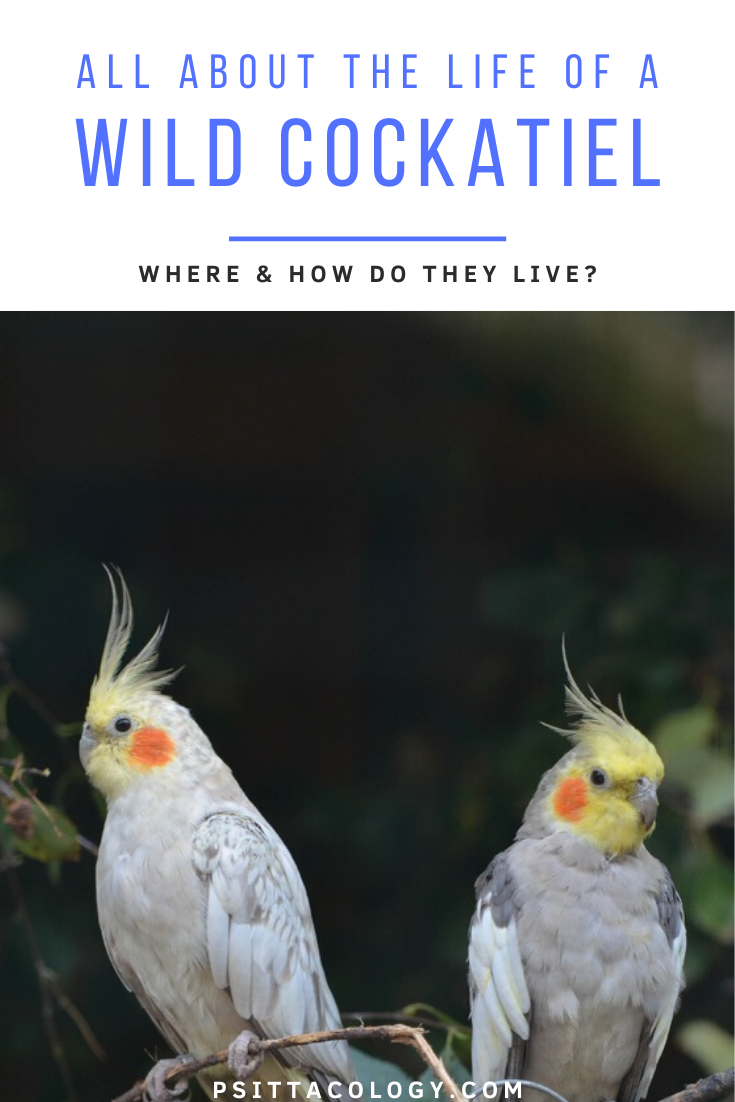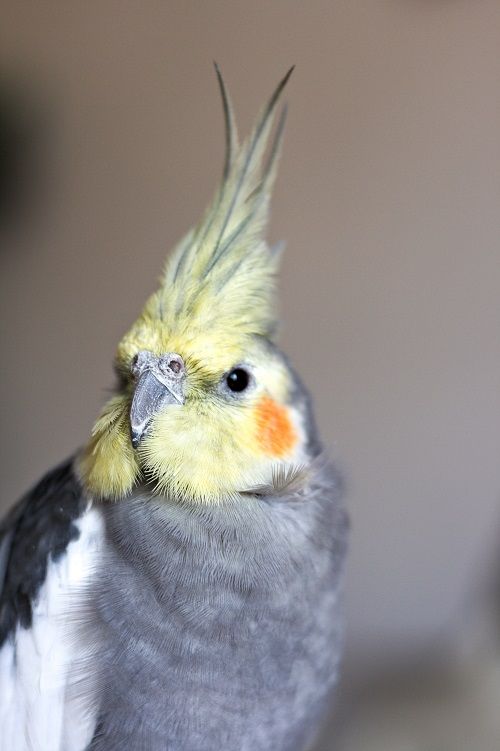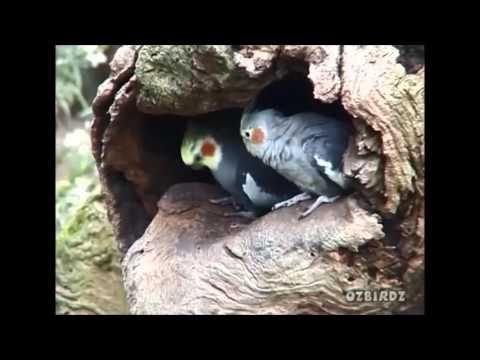If you’re trying to provide the best possible care for any pet, it’s important not to forget to take a peek at where and how it lives in the wild. After all, the species will have evolved to adapt specifically to its natural habitat and its dangers, climate, food options, and other characteristics.
This rule applies to domestic birds just like any other type of pet. If you just got a cockatiel or are thinking of buying yours soon, you might be wondering what the life of a cockatiel in the wild looks like. Keep reading to find out the answer!
Cockatiel in the wild: habitat
Also known as Nymphicus hollandicus, the cockatiel is naturally only found in mainland Australia. Sightings have also occurred on the island of Tasmania. This is rare, however, and the bird might have been introduced there by humans. As can be viewed in this map of sightings, cockatiels really are all over the place in Australia.
Wild cockatiels are nomadic, as the availability of food and water will change strongly with the seasons. Depending on the area, some will travel around constantly while others change locations with the seasons.
Characteristics of cockatiel habitat
Flocks, small groups or pairs will travel to wherever they can survive, but all suitable areas have something in common. A cockatiel in the wild has the following preferences:
- They are almost always found near water. Cockatiels are found in arid, desert-like habitats but they will stay away from areas that lack a source of water. They need quite a bit of moisture to survive.
- They prefer relatively open areas. If there are too many trees, they won’t have a clear overview of the area. Savannah grasslands and non-dense woodlands are big favorites.
- Seeds, grains and berries should be abundant. Acacia tree seeds are a big hit and areas that contain this tree species will likely contain cockatiels too. To the dismay of farmers, their crops also provide an attractive source of food to wild cockatiels. As a result, you’ll find them in and around farmland as well.
- There must be some trees present. Cockatiels prefer nesting in hollow parts of trees and won’t do so on the ground, so you won’t often find them in areas that are entirely bare. Trees also provide a safe place to perch and to rest during nighttime.
Did you know? Cockatiels are exposed to vast seasonal changes in temperature. Temperature differences of up to 40 °C between summer and winter are possible!

Cockatiel in the wild: life cycle
As mentioned above, wild cockatiels can be found in flocks that range from a single pair to a group containing many hundreds of birds. They are very social and move around the country together in their often never-ending nomadic search for food and water.
The start of a cockatiel’s life is usually marked by rainfall, especially during springtime. These rains trigger nesting and mating behavior in bonded adult cockatiel pairs. They’ll whistle, dance and even thoroughly check out the available nesting spot where they’re most likely to raise their clutch.
After the mating process, the female will lay her eggs in the approved hollow tree cavity; around five eggs can be produced over a period of several days.
After 20 days or so, tiny and helpless baby cockatiels will hatch, triggering intense caring and feeding behavior in both parents. The babies grow quickly and will be able to leave the nest in around five weeks.
They are able to start reproducing themselves in 1-1.5 years and will live for around 10 years in the wild. Spending their days socializing, preening and foraging on the ground, they will follow their flock and move around whenever food and water supplies run low.
Cockatiel in the wild: diet
One of the most important factors in pet care that we can learn about from looking at an animal’s natural habitat is diet. If we know what it eats in the wild, we’ll know what its body has adapted perfectly.
We should try to keep this diet in mind in order to keep pets like cockatiels healthy. After all, even in the wild, a cockatiel that manages to eat suitable foods will live longer than its counterparts that eat badly or too little!
Wild cockatiels mainly feed on seeds from grasses and trees. That being said, they will of course eat pretty much anything they can get their beaks on. Fruits, berries, farmers’ crops and even insects: a wild cockatiel will use much more energy than a domestic one and thus needs to eat quite a lot on a daily basis.

Cockatiels as pets
Cockatiels have never actually been domesticated, meaning a pet cockatiel is pretty much identical to a wild one except maybe in color and pattern.
Luckily for us, though, these birds can develop a mate-like bond with their owner. That’s what makes them such great pets! They often enjoy being pet, as their partner would naturally preen them. Male cockatiels talk, too: many will eagerly learn new tunes and phrases to imitate.
Your domestic cockatiel will not be wild-caught. Instead, breeders all over the world have dedicated themselves to providing this friendly species to the public, including all sorts of selectively bred color morphs that don’t exist in the wild.
Did you know? Although a wild cockatiel’s lifespan will be around 10-15 years, a domestic one can live for 30 years or occasionally even more. They thrive on a proper diet and having plenty of space to move around.

Conclusion
A cockatiel is a fantastic and friendly addition to your home if you’re looking for a bird that will enjoy your presence, learn to imitate sounds and even be quite cuddly at times. Hopefully, knowing what a cockatiel’s life looks like in the wild will help you figure out how to keep yours happy and healthy in captivity.
The most important factors to keep in mind are probably space, diet and the social aspect.
- Space: A cockatiel’s body is used to moving around and burns energy accordingly, so it should not be sitting still in its cage all day. Your bird should have a large cage that allows some level of flying, as well as plenty of toys to keep it busy.
A sedentary cockatiel can succumb to fatty liver disease and other weight/activity-related issues. Time out of the cage is a great plus and also allows you to bond with your ‘tiel.
- Diet: It can be tempting to feed your bird only seeds, since these make up the main part of their diet in the wild, but don’t forget that a wild cockatiel burns much more energy than a domestic one. Also, it does eat plenty of other things.
Seeds can make up part of your bird’s diet, but the base should consist of a high-quality pellet food. You should also be offering fresh veggies, sprouts and the occasional fruit piece. Read more in the article on cockatiel diet!
- Social: As a member of the cockatoo family, cockatiels are extremely social. Much of their lives revolve around interaction with their flock. In captivity, especially if you keep your cockatiel solo, you are a crucial part of this.
Feeling like it has its flock around helps a cockatiel feel safe, reduces stress and greatly stimulates natural behavior like mutual preening and whistling. Spend time with your bird!
Did you know? If you’d like to know more about caring for a cockatiel as a pet, have a look at the extensive cockatiel care guide.
If you have any more questions about what a cockatiel in the wild would live like or if you want to share your own experiences with these little cockatoos, don’t hesitate to leave a comment below!


WOW! I LOVE birds!